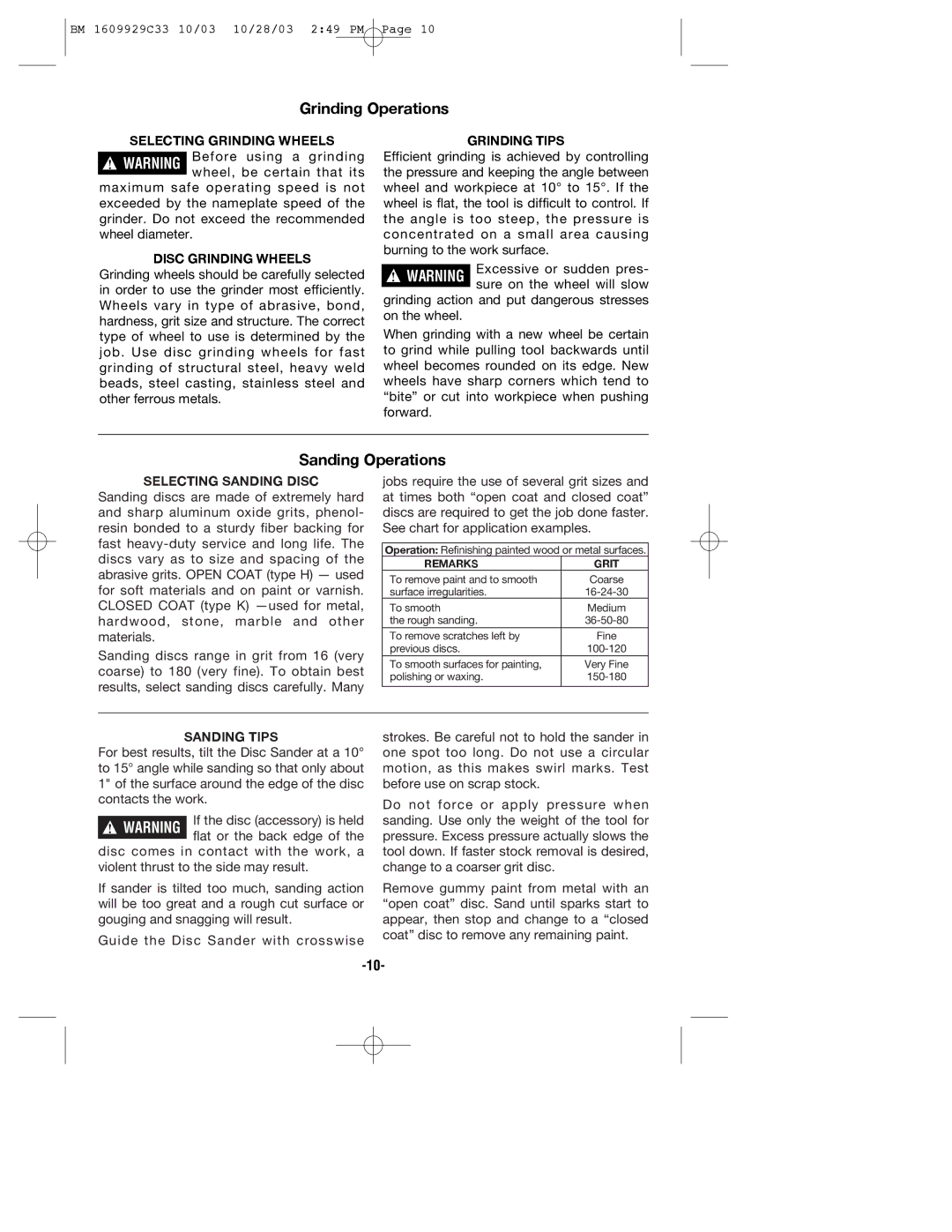
BM 1609929C33 10/03 10/28/03 2:49 PM Page 10
Grinding Operations
SELECTING GRINDING WHEELS
!WARNING Before using a grinding wheel, be certain that its
maximum safe operating speed is not exceeded by the nameplate speed of the grinder. Do not exceed the recommended wheel diameter.
DISC GRINDING WHEELS
Grinding wheels should be carefully selected in order to use the grinder most efficiently. Wheels vary in type of abrasive, bond, hardness, grit size and structure. The correct type of wheel to use is determined by the job. Use disc grinding wheels for fast grinding of structural steel, heavy weld beads, steel casting, stainless steel and other ferrous metals.
GRINDING TIPS
Efficient grinding is achieved by controlling the pressure and keeping the angle between wheel and workpiece at 10° to 15°. If the wheel is flat, the tool is difficult to control. If the angle is too steep, the pressure is concentrated on a small area causing burning to the work surface.
!WARNING Excessive or sudden pres- sure on the wheel will slow
grinding action and put dangerous stresses on the wheel.
When grinding with a new wheel be certain to grind while pulling tool backwards until wheel becomes rounded on its edge. New wheels have sharp corners which tend to “bite” or cut into workpiece when pushing forward.
Sanding Operations
SELECTING SANDING DISC
Sanding discs are made of extremely hard and sharp aluminum oxide grits, phenol- resin bonded to a sturdy fiber backing for fast
Sanding discs range in grit from 16 (very coarse) to 180 (very fine). To obtain best results, select sanding discs carefully. Many
jobs require the use of several grit sizes and at times both “open coat and closed coat” discs are required to get the job done faster. See chart for application examples.
Operation: Refinishing painted wood or metal surfaces.
REMARKS | GRIT |
To remove paint and to smooth | Coarse |
surface irregularities. | |
To smooth | Medium |
the rough sanding. | |
To remove scratches left by | Fine |
previous discs. | |
To smooth surfaces for painting, | Very Fine |
polishing or waxing. | |
|
|
SANDING TIPS
For best results, tilt the Disc Sander at a 10° to 15° angle while sanding so that only about 1" of the surface around the edge of the disc contacts the work.
! WARNING If the disc (accessory) is held flat or the back edge of the
disc comes in contact with the work, a violent thrust to the side may result.
If sander is tilted too much, sanding action will be too great and a rough cut surface or gouging and snagging will result.
Guide the Disc Sander with crosswise
strokes. Be careful not to hold the sander in one spot too long. Do not use a circular motion, as this makes swirl marks. Test before use on scrap stock.
Do not force or apply pressure when sanding. Use only the weight of the tool for pressure. Excess pressure actually slows the tool down. If faster stock removal is desired, change to a coarser grit disc.
Remove gummy paint from metal with an “open coat” disc. Sand until sparks start to appear, then stop and change to a “closed coat” disc to remove any remaining paint.
